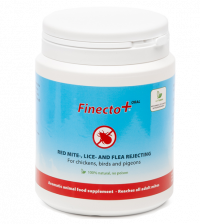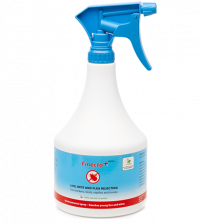Red mites in birds
Red mites in birds such as canaries are a persistent problem. If the canaries suffer from lice then it is a hard to get rid of them. This because red mites multiply rapidly and pesticides do not work against the eggs. So just when you think there gone, the last eggs start hatching.
Symptoms of red mites in birds
Red mites have the behavior to hide during the day in cracks and seams and to suck blood at night, only once in six days. This makes it difficult to spot the red mites in the aviary on time. They look for the nearest spot to the canaries where the canary can not catch them. This is often around the nests. Red mites hardly occur in the outdoor aviary, but if they do you can find them in the summer there. In addition to the Finecto Test, you can recognize red mites in your birds by the following symptoms:
- Birds are restless and have visible stress / itching
- Birds seem dull
- Dead young canaries in the nest that look white
- Eggs outside the nests
- Birds have rough feathers
- Dark chinks and seams in the aviary

- Makes the blood unattractive for mites
- 100% natural, does not contain poison
- No waiting time. The eggs can still be eaten during and after the treatment
- If ordered before 16.00 hours, shipped the same day!
- 300 gram

- Makes animals and environment unattractive for red mites
- 100% natural, does not contain poison
- Eggs can be eaten without having to wait
- If ordered before 16.00 hours, shipped the same day
- 1000ml

How do red mites look like?
Red mites change in every stage of the life cycle. As eggs they look like white dots. After hatching they are a small white / transparent mites. They turn red after their first time of eating blood. The older, the darker red, almost black. On the right picture you can see the different stages.
Behavior red mites
Because an adult red mite lays 8 eggs per day, red mites in birds multiply enormously fast, especially in hot sweltering weather. Just go over, you start with 2 red lice. After a week, these are 16 adult mites, each of which also has 8 eggs per day. So after 2 weeks there are even more than 900 red mites in the avairy!
And then we are not talking about the number of eggs that are already ready to come out. Eggs from the red mites can also hibernate. That is why it is wise to always start a preventive treatment before the warm period begins, in March.
Life cycle of the red mite
An adult red mite moves to bird once every 6 to 10 nights to suck blood. This feed is enough for her to produce eggs for 6 to 10 days. Depending on the temperature they hatch after 2-3 days. These are the small white mites in the first larval stage. They pupate after 1-2 days into a proto-nymph, the second larval stage.
After having eaten blood for the first time they pupate into a deuto-nymph. The third larval stage. They need 12 – 48 hours to pupate into an adult mite. A whole cycle can be completed in 6 days!
The adult mite normally lives for 6 to 8 weeks. But when the circumstances deteriorate due to a lack of feed or cold, an adult mite can survive for years in a sort of latent condition.
Mite eggs too can keep for years without hatching. When there is feed again they will soon emerge once more.



